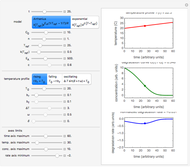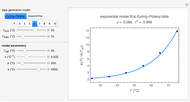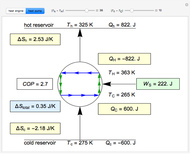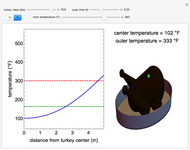Apple in a Carnot Refrigerator

Requires a Wolfram Notebook System
Interact on desktop, mobile and cloud with the free Wolfram Player or other Wolfram Language products.
This Demonstration shows work done, heat transfer, efficiency coefficient and cost of power for a Carnot ideal refrigerator as it cools an apple. You can vary the ambient and internal temperatures and the mass of the apple. Assume that the apple is initially at ambient temperature and that the temperature of the refrigerator does not change when the apple is put in. The cost of electricity is $0.1796 per kilowatt hour and the apple’s specific heat capacity is 3.64 J/g K.
Contributed by: Mason Gardiner, Mithun Vidhya-Ponraj and Gabriel Bell (August 2022)
Open content licensed under CC BY-NC-SA
Snapshots
Details
Snapshot 1: a small apple in a Carnot refrigerator operating at relatively low ambient temperature and a high refrigerator temperature
Snapshot 2: a large apple in a Carnot refrigerator with a high ambient temperature and a low refrigerator temperature
Snapshot 3: a medium apple in a Carnot refrigerator with a medium ambient temperature and a medium refrigerator temperature
References
[1] The Green Age. "Coefficient of Performance and Seasonal Performance Factor." (Apr 5, 2022) www.thegreenage.co.uk/coefficient-of-performance-seasonal-performance-factor.
[2] The Engineering ToolBox. "Food and Foodstuff-Specific Heat." (Apr 5, 2022) www.engineeringtoolbox.com/specific-heat-capacity-food-d_ 295.html.
[3] F. Wu. "Apple Image" from the Wolfram Demonstrations Project—A Wolfram Web Resource. demonstrations.wolfram.com/AppleImage.
[4] J. E. Geusic, E. O. Schulz-DuBois and H. E. D. Scovil, "Quantum Equivalent of the Carnot Cycle," Physical Review, 156(2), 1967 pp. 343–351. doi:10.1103/PhysRev.156.343.
[5] U.S. Energy Information Administration. "Michigan State Energy Profile." (Apr 5, 2022) www.eia.gov/state/print.php?sid=MI.
[6] D. W. Oxtoby, H. P. Gillis and N. H. Nachtrieb, Principles of Modern Chemistry, 5th ed., Pacific Grove, CA: Thomson/Brooks/Cole, 2002 Sec. 8.4.
Permanent Citation
















